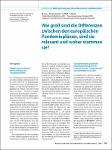Wie groß sind die Differenzen zwischen den europäischen Pandemieplänen, sind sie relevant und woher stammen sie?
Differences in European influenza pandemic preparedness plans, how important are they and what are the underlying reasons?
Haas, Walter
Straetemans, Masja
Pfaff, Günter
Nicoll, A.
Die Koordination der Influenzapandemieplanung innerhalb Europas ist für Deutschland von besonderer Bedeutung, da 10 von 16 Bundesländern an Nachbarstaaten angrenzen. Hierbei müssen nicht nur sprachliche Barrieren überwunden werden. Die Schaffung eines europäischen Frühwarnsystems durch Vernetzung der Surveillance-Strukturen und eines Kommunikationsnetzwerkes sind erste wichtige Schritte. Verschiedene Abstimmungsinstrumente wurden entwickelt, und das neu geschaffene Europäische Zentrum für die Prävention und die Kontrolle von Krankheiten (ECDC) übernimmt eine wichtige Rolle bei der Koordination und Erfassung der Planungsfortschritte. Die Umsetzungsgeschwindigkeiten der einzelnen Mitgliedstaaten bezüglich der Vorbereitung auf eine Influenzapandemie und die Schwerpunkte ihrer Planungen variieren. Die hier vorliegende Analyse aus dem europäischen, nationalen und lokalen Blickwinkel soll die Chancen und Risiken dieser Diversität für die Bewältigung einer Pandemie aufzeigen. Regionale Initiativen zur grenzüberschreitenden Umsetzung der Planungen und der Maßnahmen im Krisen management spielen eine besondere Rolle bei der Vorbereitung auf eine Influenzapandemie. The coordination of influenza pandemic preparedness planning within Europe is especially important for Germany with 10 out of 16 Länder (regions) bordering neighbouring countries. The language barrier presents only one of the challenges to overcome. Creating a European early warning system by linking national surveillance structures and the development of a communication network are important initial achievements. Several instruments have been designed and the European Centre for Disease Prevention and Control has already played a major role in the coordination of this process. It has also led the assessment of preparedness and planning by Member States. The speed of the European Member States in preparing for and the foci they have chosen when dealing with an influenza outbreak are heterogeneous. The simultaneous analysis presented here from European, national and regional points of view aims to identify both opportunities and risks of this diversity in Europe for coping with a new pandemic. Regional and local initiatives for cross-border measures and crisis management will play a central role in achieving successful influenza pandemic preparedness in Europe.
No license information

